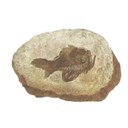Print ISSN: 0031-0247
Online ISSN: 2274-0333
Frequency: biannual
stratigraphy and biochronology of Oligo-Miocene of Kazakhstan
Additions to the elasmobranch fauna from the upper Cretaceous of New Jersey (middle Maastrichtian, Navesink Formation)
Notidanodon tooth (Neoselachii: Hexanchiformes) in the Late Jurassic of New Zealand
Eocene otoliths (Clinchfield Formation), Georgia
Abstract book of the 18th Conference of the EAVP
Eocene (57) , Quercy Phosphorites (38) , Systematics (32) , Rodents (29) , Mammalia (27)

|
Designating a lectotype for Mesacanthus pusillus (Gnathostomata: Acanthodii)Matthew Baron and Kevin SeymourKeywords: acanthodians; Chordata; Devonian; Midland Valley; Orcadian Basindoi: 10.18563/pv.44.1.e2 Abstract The early gnathostome genus Mesacanthus is well represented in both Lower Old Red Sandstone and Middle Old Red Sandstone assemblages of northern and central Scotland. This ‘acanthodian’ taxon is currently thought to comprise two valid species: M. mitchelli and M. pusillus. Although the whereabouts of the holotype of M. mitchelli (NHMUK PV P560) is known, the syntype material for M. pusillus has long been thought lost. Here we identify at least one specimen that formed part of the original syntype material for M. pusillus, albeit in a slightly different condition than when it was originally figured. This specimen is ROM 25872, which is here designated as the lectotype. A second specimen – ELGNM 1978.191.1 – could represent another of the syntype specimens, but poor preservation quality makes it impossible to be certain. Article infos Published in 44-1 (2021) |
|
S.I. Data |

|
Les vertébres dévoniens de la Montagne Noire (Sud de la France) et leur apport à la phylogénie des pachyosteomorphes (Placodermes Arthrodires).Hervé Lelièvre, Raimund Feist, Daniel Goujet and Alain BlieckKeywords: Devonian; Montagne Noire; New taxon; PHYLOGENY; Placoderms; Stratigraphy; VertebrateAbstract Several different taxa of jawed vertebrates are reported for the first time from the Devonian of south-eastern Montagne Noire, France. Besides some undeterminable fragments of placoderm fishes from the Pragian and Lower Emsian, the material from the Upper Devonian is mainly represented by Melanosteus occitanus gen. and sp. nov. (Frasnian) and Thoralodus cabrieri LEHMAN, 1952 ("Famennian"). The good state of preservation of Melanosteus allows a detailed anatomical study leading to a phylogenetic analysis of the selenosteid pachyosteomorphs. Article infos Published in Vol. 17, Fasc. 1 (1987) |
|
|

|
Norselaspis glacialis n.g., n.sp, et les relations phylogénétiques entre les kiaeraspidiens (Osteostraci) du dévonien inférieur du Spitsberg.Philippe JanvierKeywords: Devonian; kiaeraspids; Osteostraci; SpitsbergenAbstract The anatomy of Norselaspis glacialis n.g., n.sp., a primitive kiaeraspidian from the Lower Devonian of Spitsbergen, is described on the basis of spécimens studied by grinding sections or prepared with dilute formic acid. This study yielded some new anatomical details, including the presence of a canal prolonging posteromedially the canal alloted to the facial nerve by Stensiö. This posterior prolongation of the « facial canal ›› into the posterolateral part of the labyrinth cavity is consistent with the hypothesis put forward by Allis, Lindström, Jefferies and Whiting, that this canal housed the glossopharyngeus nerve. Furthermore, in N. glacialis, the foramen usually referred to as the foramen for the œsophagus opens posteriorly into a cavity in the postbranchial wall, referred to here as the intramural cavity, and which is interpreted as having housed the heart. Consequently, the œsophagus probably accompanied the dorsal aorta through the aortic canal. Finally, the foramen generally interpreted as having transmitted the ventral afferent arterial trunk is here considered as having housed the hepatic vein, which emptied into the venous sinus of the heart. The ventral afferent arterial trunk may thus have passed through the former «œsophageal ›› foramen. Article infos Published in Vol. 11, Fasc. 2-3 (1981) |
|
|

|
A new vertebrate locality in the eifelian of the khush-yeilagh formation, Eastern Alborz, IranAlain Blieck, Farrokh Golshani, Daniel Goujet, Amir Hamdi, Philippe Janvier, Elga Mark-Kurik and Michel MartinKeywords: Devonian; Iran; khush-yeilagh formation; VertebrateAbstract A new Devonian vertebrste locality has been discovered in 1976 in the basal part of the Khush-Yeilagh Formation in the eastern Alborz Mountains of Iran. The fossils occur in a band one centimeter thick which is identifiable at other outcrops in the area. A preliminary study of the remains has yielded the following faunal list : Placodermata (Phlyctaeniida indet.. Groenlandaspididae indet.. Coccosteidae indet., Holonema sp., Ptyctodontida indet., Antiarcha indet., Bothriolepis cf. kwangtungensis), Elasmobranchii (Ctenacanthidae indet.), Acanthodii (Gyracanthus sp., « Onchus » overathensis, Ischnacanthiforme indet.), Dipnoi (? Dipteridae indet.), « Crossopterygii ›› (Onychodus cf. sigmoides, Holoptychiidae indet., Osteolepididae indet.). This fauna is older than the Middle Givetian and probably of Middle or Lower Eifelian age. Owing to its diversity, it may prove possible to use it in the future as a reference fauna for the study of the Devonian vertebrates in Central Asia and the Middle East. Article infos Published in Vol. 09, Fasc. 5 (1980) |
|